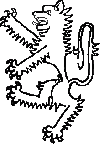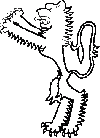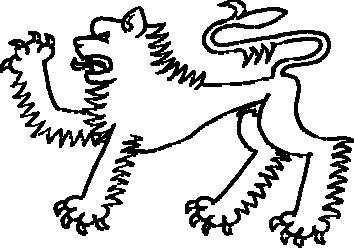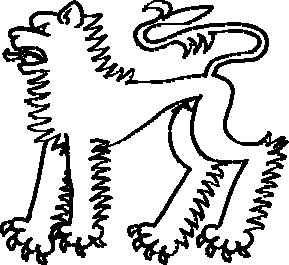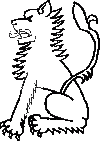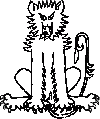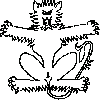Quadruped Postures: Difference between revisions
| Line 41: | Line 41: | ||
| '''Salient''' - Leaping || Body erect and elongated, forelegs out and together, rear legs together and on the ground || http://heraldry.sca.org/armory/postures/salient.gif || [[File:2salient.gif|100px]] | | '''Salient''' - Leaping || Body erect and elongated, forelegs out and together, rear legs together and on the ground || http://heraldry.sca.org/armory/postures/salient.gif || [[File:2salient.gif|100px]] | ||
|- | |- | ||
| '''Courant''' - Running || Body elongated, head erect, all four legs extended. || http://heraldry.sca.org/armory/postures/courant.gif || [[File:2courant.gif| | | '''Courant''' - Running || Body elongated, head erect, all four legs extended. || http://heraldry.sca.org/armory/postures/courant.gif || [[File:2courant.gif|200 px]] | ||
|- | |- | ||
| '''Passant''' - walking || Body horizontal, head angled or erect, three feet touching the ground with the right foreleg raised. || http://heraldry.sca.org/armory/postures/passant.gif || [[File:2passant.gif]] | | '''Passant''' - walking || Body horizontal, head angled or erect, three feet touching the ground with the right foreleg raised. || http://heraldry.sca.org/armory/postures/passant.gif || [[File:2passant.gif]] | ||
Revision as of 21:14, 17 August 2020
WARNING: Do not cite this page as a reference. This page is on this wiki only to make the content "searchable" and easier to find. If you find the information you seek here, go to the original sources as linked below to verify the information and use them for your documentation.
Illustrations:
Images from period sources:
| 16th | 16th |
| 16th Century German animals issuant from bends or inverted or ? | 16th Century Iberian animals issuant from bends or inverted or ? |
SENA Appendix L:
A Partial List of Postures and Orientations This is a list of postures and orientations that can be used to determine whether two charges or groups of charges conflict or whether there is a distinct change for posture/orientation.
Animate Charges A. Quadrupeds: The postures listed within each group generally conflict, though a distinct change may be given for facing to dexter or to sinister.
- rampant, segreant, salient, sejant erect, statant erect
- passant, statant, courant
- sejant, sejant erect
- couchant, dormant
- sejant erect affronty, sejant affronty
http://heraldry.sca.org/laurel/sena.html#AppendixL
Quick Reference - Quadrupeds and Their Postures
http://heraldry.sca.org/armory/quadruped-postures.html
Finally, the position of the head, if not looking 'forward', is blazoned explicitly. If the beast is looking at the viewer, it is considered "gardant" and if it is looking back over its shoulder, it is considered "regardant". Thus:
 |
 |
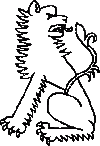
|
| a lion sejant | a lion sejant gardant | a lion sejant regardant |
Other Postures:
Clymant = same as salient, used for goats per Parker.
"pascuant or pasquant used of animals when grazing": http://www.burkes-peerage.co.uk/articles/heraldry_p.aspx]
"Paissant, or Pascuant,=grazing." "Pascuant, (fr.) or Paissant: applied only to cattle grazing with the head touching the ground. If the head is in the usual position statant would be employed." @http://www.heraldsnet.org/saitou/parker/Jpglossp.htm
[See 1989 Precendent below for only example of a grazing animal found in O&A on 14 September 2013.]
Precedents:
Jan 2018 - quadruped affronty restricted
From Wreath: Quadrupeds Affronty On the October 5, 2017, LoPaD, we asked commenters for armorial examples of quadrupeds affronty, to determine whether prior precedent about dragons "displayed" (i.e. statant erect affronty) being a step from period practice should be overturned. The intent of the request was to determine whether quadrupeds affronty were common in period armory. If so, then having a dragon affronty was a natural extension of that pattern and should not be penalized... Based on period examples, the only affronty posture for quadrupeds that is justifiable at all is sejant erect affronty, and even that has only one example that isn't dependent upon circumstances outside the crest itself. Therefore, after the August 2018 LoAR, use of the posture sejant erect affronty will be a step from period practice for non-lions, whether winged or not. All other affronty postures for quadrupeds will be disallowed after the August 2018 LoAR unless documentation is provided. [Thus dragons, being quadrupeds, can no longer be displayed. Wyverns can, being two-legged, per CL defining wyverns vs. dragons, see above.] https://heraldry.sca.org/loar/2018/01/18-01cl.html#5
September 2003 - statant vs courant
"There is no difference between statant and courant, because the evidence which has so far been obtained indicates that these postures were interchangeable in period." & "Statant should thus not be given difference from courant, because it was interchangeable with courant in period - just as passant was interchangeable with courant in period." September 2003 LoAR
==May 2002 - inverted animate charges "The SCA has general precedents against registering inverted animate charges unless they are part of a radially symmetrical group such as in annulo. These precedents are on the grounds that such inverted animals are generally not readily identifiable, and they are not found in period heraldry. However, the SCA also has a registration tradition of allowing animals which are usually found in a tergiant posture to be registered in the tergiant inverted posture. "
- "There is very little period evidence for tergiant inverted animals in heraldry."
- "As a result, inverting a tergiant charge is acceptable as long as it does not otherwise violate any basic heraldic principles, including the requirement for identifiability. Because of the lack of period evidence for tergiant inverted charges, the posture will be considered a clear step from period practice (also known informally as a "weirdness") for any charge that cannot be found in this posture in period."
August 2001 - passant vs courant
"there should not be a CD between passant and courant" & "There is a significant amount of evidence implying that courant and passant were used interchangeably in English armory." August 2001 LoAR
October 2000 - inverted animals
By precedent we do not register inverted animals unless they are part of an arrangement in annulo." October 2000 LoAR
February 1999 - inverted animate charges
"We do not allow inverted animate charges in SCA heraldry except when in recognized orientation, such as in annulo." February 1999 LoAR
March 1996 - rear ends
The south end of a dragon going north is not a suitable subject for heraldry. You could have a dragon's tail emerging from a cave or from behind a rock ... or a dragon's tail couped and served on a platter for Twelfth Night. But not a dragon's fundament escaping over a wall. (Karina of the Far West, 17 Aug 78, p. 9)
December 1989 - grazing
Gizela Balbina Teucer - The following device associated with this name was registered in December of 1989 (via the Outlands): Azure, a gazelle grazing guardant atop a trimount couped, all within a chaplet of thorn Or. [[1]]
November 1982 - dancing
"Dancing is not a heraldic position." [Mary Katherine de Macey, November 1982, R-Middle]

